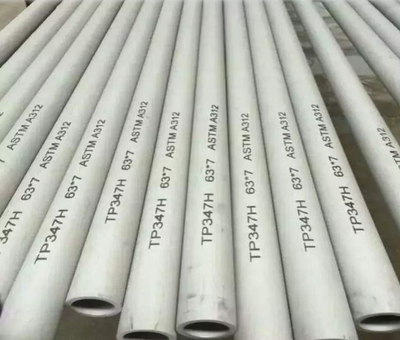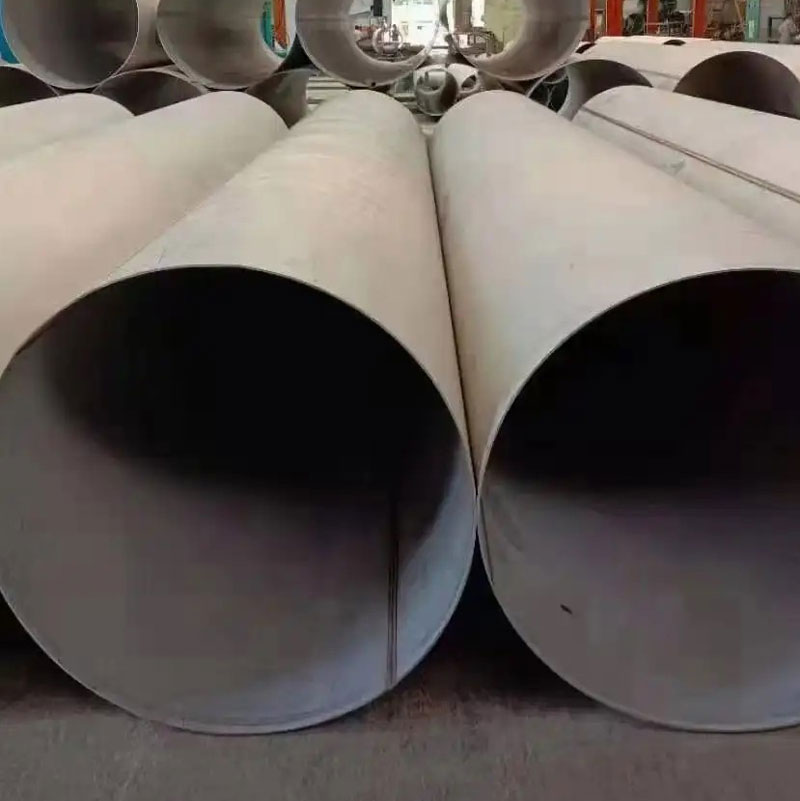What is the difference between 347H and 316L stainless steel pipes?
347H and 316L stainless steel pipes differ significantly in alloy composition, mechanical behavior, corrosion resistance, and operating environments. Understanding these differences helps engineers and end users select the right material for high-performance and cost-effective applications. Below, Ganyeah Group provides an in-depth comparison of 347H vs 316L stainless steel pipes across six key dimensions.

347H stainless steel pipes for power plant and chemical applications
1. Key Alloying Elements
| Element | 347H | 316L | Role |
|---|---|---|---|
| Carbon (C) | 0.04–0.10% (high carbon) | ≤0.03% (low carbon) | High carbon enhances high-temperature strength, while niobium stabilization prevents intergranular corrosion. Low carbon minimizes sensitization during welding. |
| Chromium (Cr) | 17–19% | 16–18% | Forms a stable passive layer and provides oxidation resistance. |
| Nickel (Ni) | 9–13% | 10–14% | Stabilizes austenitic structure and improves toughness. |
| Niobium (Nb) | 8C–1.10% | — | Combines with carbon to form NbC, preventing chromium carbide precipitation and enhancing intergranular corrosion resistance. |
| Molybdenum (Mo) | — | 2.0–3.0% | Improves resistance to pitting and crevice corrosion in chloride-containing environments. |
2. Key Performance Comparison
High-Temperature Strength
- 347H stainless steel pipe:
Minimum tensile strength ≥515 MPa (ASTM A213). It retains allowable stress above 100 MPa at 600 °C and offers oxidation resistance up to 850 °C (for non-pressurized parts). Commonly used in ultra-supercritical boilers and reheaters. - 316L stainless steel pipe:
Tensile strength ≥520 MPa (ASTM A312), but its strength decreases rapidly above 600 °C. Maximum continuous service temperature is about 590 °C, suitable for low-to-medium temperature structures.
Corrosion Resistance
- Intergranular Corrosion:
347H is stabilized with niobium and can resist intergranular attack after welding without post-weld heat treatment. 316L relies on ultra-low carbon to prevent sensitization, but excessive heat input may still induce carbide precipitation. - Pitting & Crevice Corrosion:
Due to 2–3% molybdenum, 316L has a Pitting Resistance Equivalent Number (PREN) of around 26—significantly higher than 347H (~18). It performs better in seawater and chloride-rich environments. - Molten Salt Corrosion:
347H performs excellently in molten salt at 450–565 °C, making it ideal for solar thermal storage tanks. In contrast, 316L suffers from reduced stability due to Mo reactions in molten salt media.
Fabrication & Welding
- 347H stainless steel pipe:
Exhibits work hardening during cold forming; intermediate annealing at 850–900 °C is recommended. Welding should use ER347 filler with controlled heat input ≤1.5 kJ/mm and interpass temperature ≤150 °C to prevent NbC segregation. - 316L stainless steel pipe:
Excellent formability and weldability. Commonly welded using ER316L or flux-cored wire TGF-316L without argon purging, offering high field efficiency and low sensitization risk.

316L stainless steel welded pipes producted by Ganyeah
3. Typical Applications
| Industry | 347H Stainless Steel Pipe | 316L Stainless Steel Pipe |
|---|---|---|
| Power Generation | Superheater and reheater tubes in ultra-supercritical boilers, molten salt storage systems in solar plants | Steam generator tubes and low-temperature piping |
| Petrochemical | Ethylene cracking furnace tubes, hydroprocessing reactors | Reactors, acetic acid storage tanks, seawater-cooled condensers |
| Marine | Limited use due to lack of Mo | Ship structures, desalination systems, offshore platforms |
| Food & Pharma | Not typically used | Food processing and pharmaceutical equipment |
| Architecture | High-temperature exhaust ducts | Decorative panels, sanitary fittings |
4. Processing & Cost
- Manufacturing:
347H requires strict control of hot-rolling temperature (1150–1200 °C) and solution treatment (1020–1100 °C water quenching) to dissolve NbC completely.
316L benefits from well-developed cold drawing and polishing technologies, making it more economical for large-scale use. - Market Price (2025 reference):
347H stainless steel pipe (Φ51×8 mm): ¥28,000–32,000/ton – about 10–15% higher than 316L.
316L stainless steel pipe: ¥25,000 – 28,000/ton, offering a better cost-performance ratio.
5. Standards & Specifications
| Standard Type | 347H | 316L |
|---|---|---|
| International | ASTM A213 / SA213 | ASTM A312 |
| Chinese | GB/T 5310 | GB/T 14976 |
| European | EN 10216-5 | EN 10088-2 |
6. Selection Guide
Choose 347H Stainless Steel Pipe when:
- Operating temperature exceeds 550 °C, such as in power plant boilers or solar thermal systems.
- Post-weld heat treatment is not feasible – niobium stabilization ensures corrosion resistance.
- Components face sulphidation or carburizing conditions in refinery environments.
Choose 316L Stainless Steel Pipe when:
- Working in chloride-rich or marine conditions.
- Requiring frequent welding without post-annealing.
- Cost efficiency and high cleanliness are priorities, such as in food or medical equipment.
Final Insights from Ganyeah Group
The essential distinction between 347H and 316L stainless steel pipes lies in their alloying philosophy – niobium in 347H enhances high-temperature stability and intergranular corrosion resistance, while molybdenum in 316L offers superior chloride corrosion protection and cost-effectiveness.
At Ganyeah Group, we manufacture both 347H stainless steel pipes and 316L stainless steel pipes in compliance with ASTM, EN, and GB standards. With advanced heat treatment, precision welding, and quality control systems, we deliver reliable piping solutions tailored to high-temperature and corrosive service environments.
